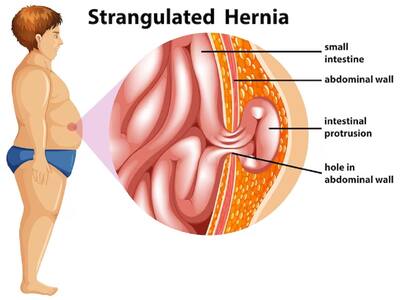
From open surgery to robotics and abdominal wall reconstruction, there has been significant advancements in the treatment of hernia, resulting in better health outcomes for patients.
Hernias of the abdomen refers to a condition where there is a weakness or gap in the abdominal wall, often involving muscles, allowing the contents of the abdomen to protrude outward, resulting in swelling on the abdomen. Hernias can occur in different areas of the abdominal wall, with the most common locations being the groin called inguinal hernia. Other common types include umbilical hernias near the belly button and incisional hernias, which occur in areas weakened by previous surgeries. Diaphragmatic hernias, such as those located between the chest and abdomen, can also develop in these regions.
Symptoms of hernia typically include swelling, and in some cases, mild pain and discomfort. While complications are rare, there is a possibility that the hernia contents may become trapped, which requires immediate medical attention. This risk of complications is why hernias are often treated through surgery, as the consequences can be severe when complications occur.
Advances in Hernia Treatment
Over the last few years, hernia surgeries have undergone significant changes in their approach and techniques. Initially, open surgery, involving incisions directly over the hernia, was the primary method employed. However, the introduction of meshes around 50 years ago revolutionized the field of hernia surgery.
In addition to these advancements, there has been a slight shift in the way hernia surgeries are performed, particularly in the past decade, with a greater emphasis on reconstructing the abdominal wall. The abdominal muscles, responsible for encompassing and safeguarding the abdominal contents, play a crucial role in maintaining the integrity and functionality of the abdomen. Whenever there is a weakness in these muscles, such as with large incision hernias or post-pregnancy, the muscles may shift to the sides. This can compromise the function of the spine, leading to back pain. Consequently, the abdominal wall along with its associated muscles, plays a vital role in our day-to-day activities.
Hernias can create weak spots that impact the functionality of the abdomen. During hernia surgery, the focus is on restoring the integrity of the abdominal wall to preserve its functionality. In recent times, there has been a notable shift towards the adoption of Abdominal Wall Reconstruction (AWR) techniques. AWR involves recreating the structural integrity of the abdominal wall, and these surgeries can be performed using laparoscopic, minimally invasive, open, or robotic methods. In the event of complications, the robotic method stands out as an excellent option.
READ RELATED: "I Lost 100 Pounds—Here's How I Did It"
Affordability and Accessibility in Hernia Treatment
In the past, hernia surgeries involved the use of expensive meshes and implants, adding to the overall cost of the procedure. However, with the introduction of Abdominal Wall Reconstruction (AWR) techniques, the need for such costly equipment has been reduced. Nowadays, surgeons can achieve the same level of surgical quality through minimally invasive or robotic-assisted methods, reducing the financial burden on patients. Depending on the strength of the abdominal wall, some patients may still require more expensive meshes, but overall, the cost of hernia surgery has become more manageable.
Advancements in technology have significantly contributed to improved surgical outcomes. The instruments used in both laparoscopic and robotic-assisted surgeries have undergone refinement and offer greater precision. This translates to higher-quality treatment for patients. In minimally invasive procedures, scars are minimized, and post-surgery recovery is faster. Previously, patients would stay in the hospital for several days, whereas now, the average hospital stay has been reduced to 1-2 days. Furthermore, the introduction of day-care procedures allows patients to be admitted in the morning and return home on the same day.
As advancements continue, doctors are actively educating patients about hernias and ensuring a clear understanding of the treatment process. Patient counseling and consent have become integral components of the surgical journey, enhancing patient engagement and involvement in their own healthcare decisions.
The writer is Dr Muralidhar S Kathalagiri, Senior Consultant Laparoscopic, Robotic Bariatric and GI Surgeon, SPARSH Hospital.
Total Wellness is now just a click away.
Follow us on
window.addEventListener(‘load’, (event) => {
$(‘#commentbtn’).on(“click”,function(){
(function(d, s, id) { var js, fjs = d.getElementsByTagName(s)[0]; if (d.getElementById(id)) return; js = d.createElement(s); js.id = id; js.src = “//connect.facebook.net/en_US/sdk.js#xfbml=1&version=v2.3”; fjs.parentNode.insertBefore(js, fjs);}(document, ‘script’, ‘facebook-jssdk’));
$(“.cmntbox”).toggle();
});
});









